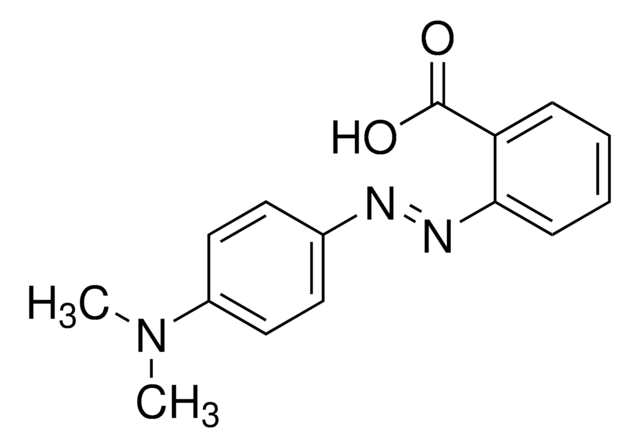1.01322
Methyl orange (C.I. 13025)
pH indicator, ACS, Reag. Ph Eur
Synonym(s):
Methyl orange (C.I. 13025), 4-Dimethylaminoazobenzene-4′-sulfonic acid sodium salt, Gold orange, Helianthine, Orange III
About This Item
Recommended Products
Product Name
Methyl orange (C.I. 13025), indicator ACS,Reag. Ph Eur
grade
ACS reagent
Quality Level
Agency
reag. Ph. Eur.
form
solid
potency
60 mg/kg LD50, oral (Rat)
loss
≤5% loss on drying, 110°C
pH
6.5 (20 °C, 5 g/L in H2O)
mp
>300 °C
bulk density
200‑400 kg/m3
storage temp.
2-30°C
InChI
1S/C14H15N3O3S/c1-17(2)13-7-3-11(4-8-13)15-16-12-5-9-14(10-6-12)21(18,19)20/h3-10H,1-2H3,(H,18,19,20)/p-1
InChI key
IETWCRRCPURZOC-UHFFFAOYSA-M
Application
- Plant-assisted green preparation of silver nanoparticles using leaf extract of Dalbergia sissoo and their antioxidant, antibacterial and catalytic applications.: This research utilized Methyl Orange as an indicator in the green synthesis of silver nanoparticles using Dalbergia sissoo leaf extract. The study highlighted its catalytic application in dye degradation, demonstrating the environmental benefits of plant-assisted nanoparticle synthesis (Khatun et al., 2024).
- Dye Degradation and Sulfur Oxidation of Methyl Orange and Thiophenol via Newly Designed Nanocomposite GQDs/NiSe-NiO Photocatalyst Under Homemade LED Light.: This study focused on the efficient photocatalytic degradation of Methyl Orange using a novel nanocomposite photocatalyst under LED light, presenting significant advancements in photocatalytic materials for wastewater treatment (Srivastava et al., 2023).
- Bryophyllum pinnatum leaf extract mediated ZnO nanoparticles with prodigious potential for solar driven photocatalytic degradation of industrial contaminants.: The research demonstrated the synthesis of ZnO nanoparticles using Bryophyllum pinnatum leaf extract and their application in the photocatalytic degradation of Methyl Orange, showcasing a sustainable approach to tackling industrial pollutants (Dhiman et al., 2023).
- Light driven Aspergillus niger-ZnS nanobiohybrids for degradation of methyl orange.: This paper explored the use of Aspergillus niger-ZnS nanobiohybrids for the degradation of Methyl Orange, emphasizing the potential of biogenic approaches in enhancing photocatalytic efficiency (Priyanka & Lens, 2022).
- Bacterially driven cadmium sulfide precipitation on porous membranes: Toward platforms for photocatalytic applications.: This study utilized Methyl Orange to assess the photocatalytic efficiency of cadmium sulfide precipitated on porous membranes by bacteria, proposing a novel method for creating photocatalytic platforms for environmental applications (Marusak et al., 2018).
Analysis Note
Appearance of solution: passes test
Loss on drying (110 °C): ≤ 5
Transition range (according to ACS): passes test
Sensitivity test: passes test
Signal Word
Danger
Hazard Statements
Precautionary Statements
Hazard Classifications
Acute Tox. 3 Oral
Storage Class Code
6.1C - Combustible, acute toxic Cat.3 / toxic compounds or compounds which causing chronic effects
WGK
WGK 3
Flash Point(F)
Not applicable
Flash Point(C)
Not applicable
Certificates of Analysis (COA)
Search for Certificates of Analysis (COA) by entering the products Lot/Batch Number. Lot and Batch Numbers can be found on a product’s label following the words ‘Lot’ or ‘Batch’.
Already Own This Product?
Find documentation for the products that you have recently purchased in the Document Library.
Customers Also Viewed
Our team of scientists has experience in all areas of research including Life Science, Material Science, Chemical Synthesis, Chromatography, Analytical and many others.
Contact Technical Service







